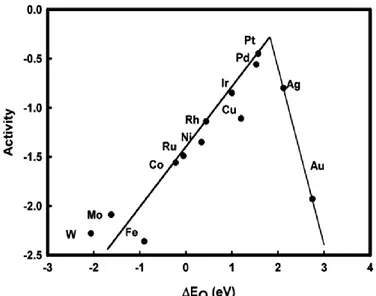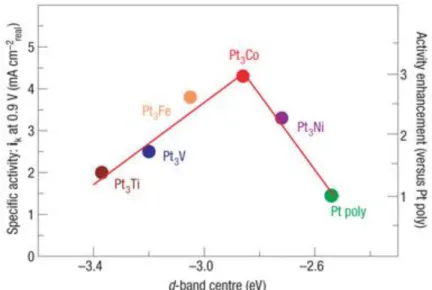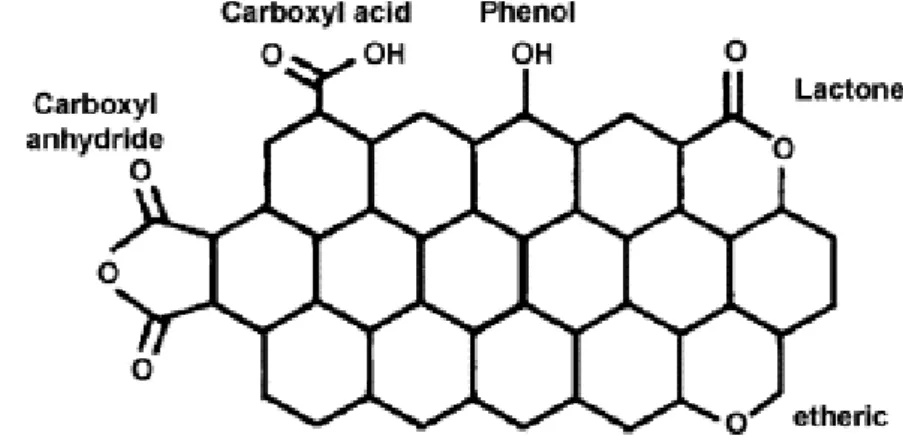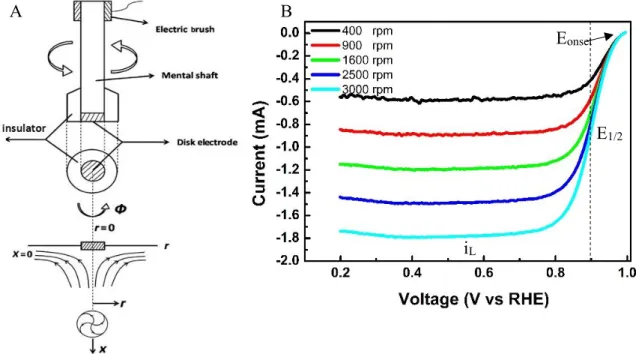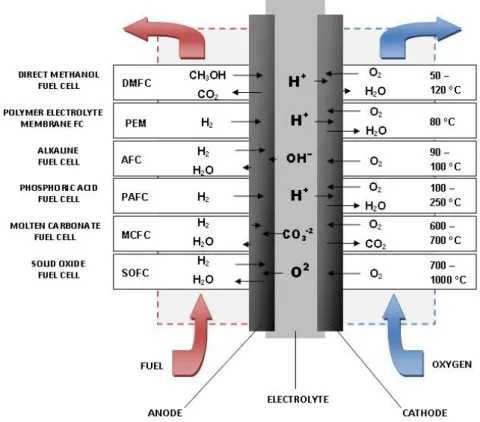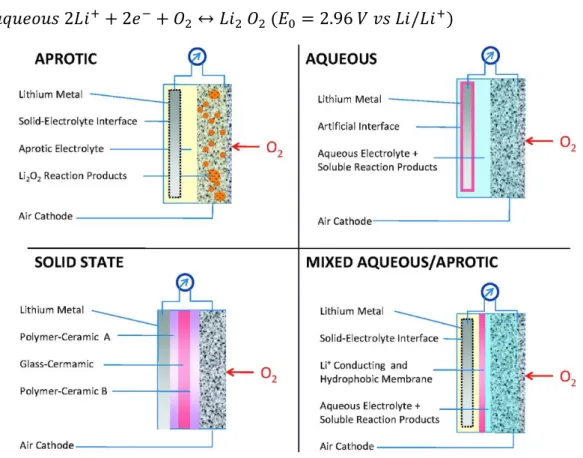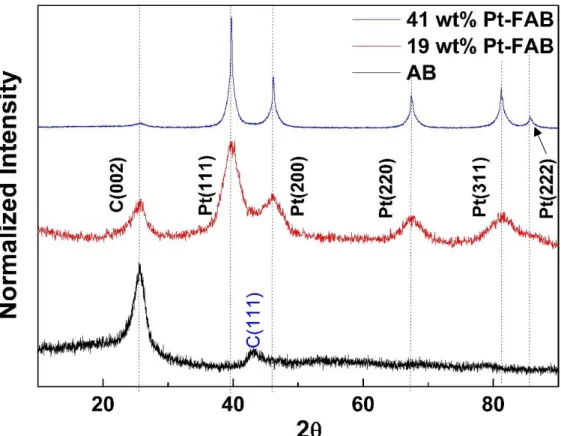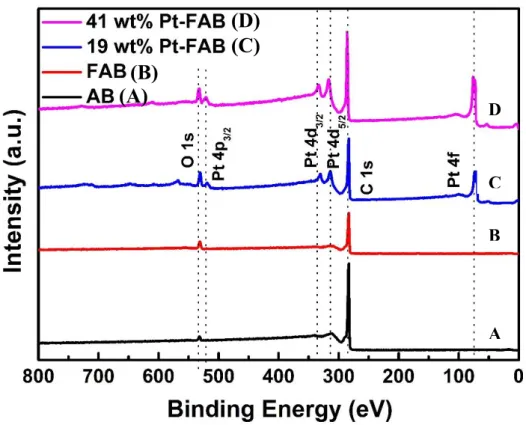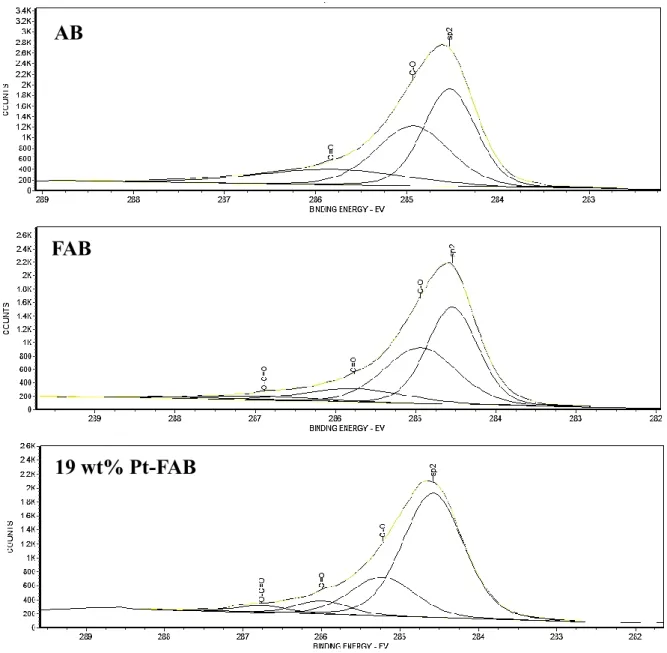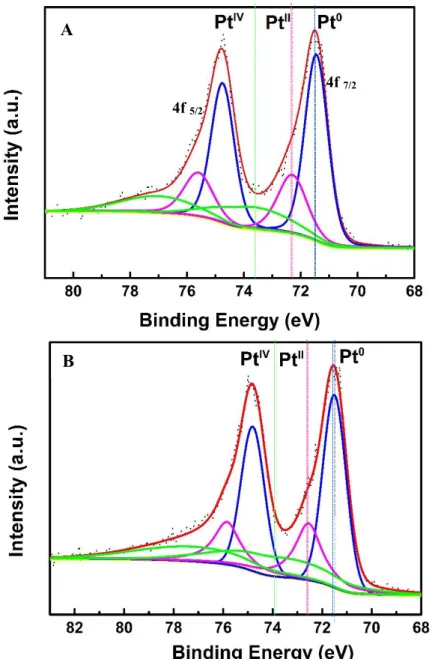JAIST Repository
https://dspace.jaist.ac.jp/
Title 燃料電池及びリチウム―空気電池用高効率酸素還元反
応触媒としての新たな炭素ナノ構造体の設計
Author(s) Badam, Rajashekar Citation
Issue Date 2016‑09
Type Thesis or Dissertation Text version ETD
URL http://hdl.handle.net/10119/13809 Rights
Description Supervisor:松見 紀佳, マテリアルサイエンス研究科
, 博士
Novel Carbon Based Nano-Architectures As Efficient Oxygen Reduction Reaction Catalysts for Fuel Cells and Li-Air
Battery
Badam Rajashekar
Japan Advanced Institute of Science and Technology
September 2016
Dedicated to my dearest grand parents
(Thatha & Bamma)
Preface
The present dissertation is submitted for the degree of Doctor of Philosophy at Japan Advanced Institute of Science and Technology (JAIST), Japan. The research work embodied in this dissertation entitled “Novel Carbon Based Nano-Architectures as Efficient Oxygen Reduction Reaction Catalysts for Fuel Cells and Li-Air Battery” is an original work carried out under the supervision of Prof. Noriyoshi Matsumi at School of Materials Science, JAIST, Japan during 2013-2016.
In the present global scenario of depleting fossil fuels and global warming, where the emission of green-house gases from the transportation and electricity generation hold the prime responsible for the global warming. A global shift from the traditional fossil fuel to more sustainable energy conversion and storage systems is the need of the hour. The applications of different types of carbon substrates to electrochemical devices, especially in the field of energy, viz., fuel cells and Li-air battery, are significant, as they project high energy density with prolonged durability. The major limiting factor that affects the efficiency of these devices is the sluggishness of the oxygen reduction reaction (ORR) at the cathode. Hence, the need for an efficient cathode material has been under continuous research.
The author’s main focus in this work is to design and develop novel and facile methodologies to prepare highly active ORR catalytic material which can be readily commercialized. For this, simple strategies were adopted to tune or tailor cost effective catalytic nanostructures with very high activity. The work presented in this dissertation covers the facile and simple functionalization techniques to the carbon substrates to induce the electrolyte absorptive or interfacial charge transfer characteristics and strong metal substrate interaction characteristics of the substrate for higher ORR activity. To the best of my knowledge, the work present original results. Neither this, nor any substantially similar dissertation has been or is being submitted for any other degree, diploma or other qualifications at any university.
Badam Rajashekar School of Materials Science
Japan Advanced Institute of Science and Technology September 2016
Acknowledgement
Firstly, the author expresses his heartfelt gratitude to Prof. Noriyoshi Matsumi, School of Materials Science, Japan Advanced Institute of Science and Technology (JAIST), for his all- embracing support, kind guidance and timely advices throughout the journey at JAIST. I am very thankful to him for his patience, motivation and heartfelt encouragement. I would like to extend my gratitude to Asst. Prof. Raman Vedarajan, as he was the first person to reach for any suggestions. I thank him for his constant support, useful critiques and innovative ideas all through the journey.
I would like to thank the members of my review committee Prof. Masahiro Miyauchi (Tokyo Institute of Technology), Prof. Kohki Ebitani (JAIST), Assoc. Prof. Yuki Nagao (JAIST), Assoc. Prof. Toshiaki Taniike (JAIST) for spending their valuable time assessing my thesis, for their insightful comments and remarks to enhance the quality of this dissertation from various perspectives.
I would like to thank Tanaka Kikinzoku for helping in RDE experiments. I express a great appreciation for the staff members of Machine shop, JAIST for their engineering expertise in the fabrication of device for testing Li-air battery. The author is very thankful to Center for Nano Materials and Technology (CNMT), Assoc. Prof. Mikio Koyano and School of Materials Science for the technical support and instrumentation. I am very thankful to Dr. Rajalakshami Natarajan for giving an opportunity to carry out fuel cell experiments at Center for Fuel Cell Technology (ARCI) IIT Madras Research Park, India. A huge thanks will not be enough for the members of CFCT for their active collaboration and warm support during my stay in India.
The author also takes this opportunity to thank all the members of Matsumi lab for their valuable inputs, support, cooperation, stimulating discussions and creating lively ambiance in JAIST.
The word ‘thanks’ will not be enough to express my gratitude to my parents, brother, wife and all the members of family for their love and relentless efforts all the time.
As a sense of gratitude, the author would like to offer everything in life to the almighty God.
Badam Rajashekar School of Materials Science
Japan Advanced Institute of Science and Technology September 2016
Abstract
The importance of Oxygen Reduction Reaction (ORR) as a principle reaction in various elelctrochemical applications have been well understood over the years. Fuel cells and Li-air battery working on the basis of ORR, which project a high energy density, prolonged durability with low emission of global warming gases have gained greater significance among plethora of electrochemical energy devices. Electrocatalyst plays an important role in realization of both these devices by enhancing the sluggish kinetics of ORR. The two interconnected materials forming the ORR catalyst are the porous & conducting carbon support and the active metal nanoparticles as ORR centres. A careful and strategic optimization in their designing of the substrate for enhanced activity, increased durability, simple preparation method for immediate commercialization and reduction of overall cost. In this view, the present work details the importance of substrate modification in enhancing above attributes of the catalytic activity of Pt/carbon based catalysts by tuning a) surface area of carbon based support b) ability to support the catalyst c) pore size d) charge transfer resistance and e) the ability to anchor Pt nanoparticles.
The chapters in this thesis, include strategies to tune one, more or all of the above mentioned intrinsic properties of the catalyst with very simple, facile and in some cases green processes which can possibly see the light of commercialization.
Chapter 2 deals with a novel single-pot method to exfoliate and functionalize acetylene black.
The deliberate functionalization was found to enhance the intrinsic oxygen reduction efficiency along with the nucleation and growth of platinum nano-particles on the surface. The prepared material was well characterized to understand the morphology, elemental composition and electrocatalytic behaviour. The resulting material showed enormously high oxygen reduction reactivity compared to its commercial counterparts. The mass activity evaluated from the rotating disc electrode (RDE) techniques was found to be higher than the target set by the
department of energy (DOE), USA. The material also showed very encouraging results when employed as cathode material for PEMFC and Li air batteries.
Electrocatalytic materials for oxygen reduction reaction, currently dominated by platinum/carbon catalyst is marred by drawbacks such as, use of copious amount of Pt and use of “non-green” sacrificial reducing agent (SRA) during the synthesis. A single stroke remedy for these two problems has been achieved through an in-situ aqueous photoreduction void of even trace amounts of SRA with an enhanced activity. Reduction of PtCl62- salt to Pt nano particles on carbon substrate was achieved solely using solar spectrum as the source of energy and TiO2 as photocatalyst. In chapter 3, it was demonstrated that this new procedure of photoreduction, decorates Pt over different types of conducting carbon allotropes with the distribution and the particle size primarily depending on the conductivity of these allotrope.
The Pt/C/TiO2 composite unveiled an ORR activity on par with the most efficient Pt based electrocatalyst prepared through the conventional sacrificial reducing agent aided preparation methods.
The development of novel substrates possessing high durability, strong anchoring to catalytic metal nanoparticle and low charge transfer resistance that can replace conventional carbon is of great importance. In order to improve the durability and reduce the cost of various energy devices, new methodologies are necessary. In this regard, chapter 4 highlights the preparation of a macroporous hybrid material containing a foam like polythiophene electropolymerized on to TNT. The prepared hybrid material showed very low charge transfer resistance and was further modified with novel and green photo-generated Pt nanoparticles. The material exhibited very strong metal substrate interaction which makes it highly durable during the ORR. This chapter proposes a novel macroporous organic/inorganic hybrid material as a candidate material that has a great probability to replace the conventional carbon substrates for ORR catalysts.
Table of Contents
Preface
Acknowledgements Abstract
Table of Contents List of Figures List of Tables
Chapter 1
Introduction to Oxygen Reduction Reaction (ORR) Catalysts and Devices Functioning on ORR
1.1. General Introduction to Oxygen Reduction Reaction and Its Catalyst………1
1.2. Mechanism of ORR………3
1.3. Introduction: ORR Catalysts………...6
1.3.1. Emphasis on Platinum (Pt) Based Catalysts………6
1.3.1.1. Facet Controlled Uni-metallic Pt Catalyst………...7
1.3.1.2. Pt Bimetallic and Multimetallic Nanocrystals………...9
1.3.2. Understanding Carbon Supported ORR Catalysts………14
1.3.2.1. Various Carbon Supports………..14
1.3.2.2. Preparation of Pt/C………15
1.3.2.3. Electronic Interaction of Pt Decorated Carbon Electrocatalysts………...15
1.3.2.4. Surface Treatment of Carbon and Its Effect on Catalytic Activity………17
1.3.3. Brief Introduction to Advanced Tri-Phasic and Pt-free ORR Catalysts………19
1.4. Introduction to Electrochemical Characterization Techniques to Evaluate ORR…….21
1.4.1. Cyclic Voltammetry………. 21
1.4.2. Rotating Disc Electrode………23
1.4.3. Electrochemical Impedance Spectroscopy………... 24
1.5. Introduction to Devices Functioning on ORR……….. 26
1.5.1. Fuel Cell………... 26
1.6. Problems Associated in Designing and Commercialization of ORR Catalysts………33
1.7. Novel Methodologies in Tackling the Problems Associated……….34
1.7.1. Need for Novel Substrates for ORR Catalysts………..34
1.7.2. Need for Novel Methods to Prepare ORR Catalysts……….35
References………36
Chapter 2 Platinum Decorated & Functionalized Defective Acetylene Black; A Promising Cathode Material for ORR 2.1. Abstract………..46
2.2. Introduction………...47
2.3. Experimental Section……….48
2.3.1. Single Pot Method for Exfoliation and Functionalization of Acetylene Black………..48
2.3.2. Platinum Decoration onto the Surface of FAB ………..49
2.3.3. Physical and Chemical Characterization………49
2.3.4. Electrochemical Characterization………...49
2.4. Results and Discussion………...50
2.4.1. Physical and Chemical Characterization………50
2.4.2. Electrochemical Characterization………...58
2.5. Application of Catalyst in Proton Exchange Membrane Fuel Cell (PEMFC)………67
2.6. Application of Catalyst in Lithium-air Battery………..71
2.7. Other Electrocatalytic (Methanol Oxidation) Properties of Acetylene Black Based Catalysts………....74
2.8. Conclusion……….………78
References..………..79
Chapter 3 Novel Sacrificial Reducing Agent Free Photo-Generation of Pt Nanoparticles on All Conducting Carbon Forms as Triple-Phase ORR Catalytic with Enhanced Activity 3.1. Abstract……….81
3.2. Introduction………...82
3.3. Experimental Section...………..84
3.3.1. Preparation of Electrocatalyst by Novel Photo-reduction Process………..84
3.3.2. Physical and Chemical Characterization……….85
3.3.4. Electrochemical Characterization………...86
3.4. Results and Discussion………...87
3.4.1. Physical and Chemical Characterizations………...87
3.4.2. Electrochemical Characterization………...94
3.5. Conclusion………...102
References………..103
Chapter 4 3D Polythiophene Foam on TiO2 Nanotube Array as a Substrate for Photo-Generated Pt Nanoparticles as an Advanced ORR Catalyst 4.1 Abstract………107
4.2. Introduction……….108
4.3. Experimental Section………...110
4.3.1. Preparation of TNT Array……….110
4.3.2. Preparation of 1-methyl- 3-dodecyl bromide (DMImBr) ……….111
4.3.3. Electropolymerization of Thiophene Using TNT as Template ………112
4.3.4. Photo-reduction of Pt onto Polythiophene-TNT Hybrid………..113
4.3.5. Chemical, Physical & Electrochemical Characterization……….114
4.4. Results and Discussion……….115
4.5. Conclusion………...123
References………..124
Chapter 5 Conclusions 5.1. General Conclusions………128
5.2. Future Scope of the Work……….132
List of Figures
Figure 1.1 Trends in oxygen reduction activity plotted as a function of the oxygen binding
energy (Ref.24). ... 5
Figure 1.2 Relationships between the catalytic properties and electronic structure of Pt3M alloys (Ref.45). ... 10
Figure 1.3 Various types of surface oxygen functional groups on carbon (Ref.73). ... 17
Figure 1.4 CV curve of the Pt catalyst showing the typical reactions on Pt and Had region. . 22
Figure 1.5 Schematic of the RDE and the electrolyte flow (Ref. 90) (A) typical ORR polarization curves showing various kinetic parameters that can be determined from the curve (B) ... 24
Figure 1.6 Typical Nyquist plot and contribution to various properties (A) and Nyquist plot of Pt-carbon and the corresponding equivalent circuit (B) (Ref. 91). ... 25
Figure 1.7 Schematic representation of fuel cell... 27
Figure 1.8 Various types of fuel cells and their operation conditions (Ref. 92) ... 28
Figure 1.9 Schematic explaining the working of PEMFC (Ref. 93) ... 29
Figure 1.10 The gravimetric energy densities (Wh/kg) for various types of rechargeable batteries compared to gasoline (Ref. 94). ... 31
Figure 1.11 Four different architectures of Li-air batteries, which all assume the use of lithium metal as the anode (Ref. 94). ... 32
___________________________________________________________________________ Figure 2.1 XRD pattern of AB, 19 wt% Pt-FAB and 41 wt% Pt-FAB... 51
Figure 2.2 TEM images of AB (A-B) Pt-AB (C-D) ... 52
Figure 2.3 TEM micrographs of 19 wt% Pt-FAB (A-B). 41 wt% Pt-FAB (C-D). ... 53
Figure 2.4 Raman spectra of AB (A) and 19 wt% Pt-FAB (B) ... 54
Figure 2.5 XPS survey spectrum of AB, FAB, 19 wt% Pt-FAB and 41 wt% Pt-FAB ... 55
Figure 2.6 Core level XPS spectra of C 1s and its deconvolution in AB, FAB and 19 wt%
Pt-FAB ... 56 Figure 2.7 Deconvolution of Pt 4f peak of 19 wt% Pt-FAB (A) and 41 wt% Pt-FAB (B) showing Pt0, PtII and PtIV valence states. ... 57 Figure 2.8 Cyclic voltammograms of AB and FAB showing ORR activity... 58 Figure 2.9 Cyclic voltammograms of 19 wt% Pt-FAB (A), 41 wt% Pt-FAB (B) and
TEC10E50E (C) and ECSA of Pt-FAB samples in comparison with
TEC10E50E (D) ... 60 Figure 2.10 Linear sweep voltammetry curves using RDE for 19 wt% Pt-FAB (A),
41 wt% Pt-FAB (C) and TEC10E50E (E) at 30 oC in oxygen saturated 0.1 M HClO4 at scan rate of 20 mV/s at different rotation speeds (400, 900, 1600, 2500, 3600 rpm) and respective Koutecky-Levich plots (B, D, E) at 0.80, 0.85 and 0.90 V. ... 62 Figure 2.11 Comparison of RDE plots of 19 wt% Pt-FAB and 41 wt% Pt-FAB with
TEC10E50E (A) MA and SA of the Pt-FAB ... 63 Figure 2.12 Nyquist plot of (A) AB and FAB (B) 19 wt% Pt-FAB and 20 wt% Pt-Vulcan
XC-72, equivalent circuits for all the materials are given in inset. ... 64 Figure 2.13 Pictorial representation explaining the elements of equivalent circuits for
19 wt% Pt-FAB and 20 wt% Pt-Vulcan XC 72. ... 65 Figure 2.14 Durability of 19 wt% Pt-FAB and 41 wt% Pt-FAB (A) and coulombic
efficiency of 19 wt% Pt-FAB in comparison with 41 wt% Pt-FAB (B)... 66 Figure 2.15 Typical polarization curve of PEMFC... 68 Figure 2.16 Polarization curves of 19 wt% Pt-FAB in 2:1 (air:hydrogen) condition (A) and
in 1:1 (oxygen:hydrogen) condition (B). ... 69 Figure 2.17 Constant pressure oxygen chamber for Li-air battery characterization ... 71
Figure 2.18 Coin cell configuration showing various components and the inset shows the perforated bottom can of the coin cell ... 72 Figure 2.19 Preliminary charge discharge profile of first cycle (A) second cycle (B) of the
Pt-FAB based Li-air battery………..73 Figure 2.20 Shows the normalized CV (A) and chronoamperograms (B) of 19 and 41 wt%
Pt-FAB catalysts in comparison with 20 wt% Pt-Vulcan XC-72 ... 76 __________________________________________________________________________
Figure 3.1 Schematic representation of the photo-reduction process ... 84 Figure 3.2 XPS survey spectra of Photo-Pt-Graphite-TiO2 (A) Photo-Pt-GO-TiO2 (B)
Photo-Pt-CNT-TiO2 (C) Photo-Pt-CNT-TNT (D) ... 89 Figure 3.3 Deconvolution of Pt 4f peak of Photo-Pt-Graphite-TiO2 (A) Photo-Pt-Graphite-
TiO2 (B) and Photo-Pt-CNT-TNT (C) showing Pt0, PtII and PtIV valence states. . 90 Figure 3.4 TEM micrographs of TiO2 nano particles (A) and TNT (B) ... 91 Figure 3.5 TEM micrographs of Photo-Pt-Graphite-TiO2 (A-B) Photo-Pt-GO-TiO2 (C-D)
Photo-Pt-CNT-TiO2 (E-F) ... 93 Figure 3.6 TEM images of Photo-Pt-CNT-TNT (A-B) ... 94 Figure 3.7 Shows cyclic voltammograms of Pt-Graphite-TiO2 (A) Pt-GO-TiO2 (B) Pt-CNT-
TiO2 (C) Pt CNT-TNT (D) TEC10E50E (E) and ECSA calculated from above voltammograms (F) ... 96 Figure 3.8 RDE curves for Photo-Pt-Graphite-TiO2 (A), Photo-Pt-CNT-TiO2 (C) and
Photo Pt-CNT TNT (E) at 30 oC in oxygen saturated 0.1 M HClO4 aq. at scan rate of 20 mV/s at different rotation speeds (400, 900, 1600, 2500, 3600 rpm) and respective Koutecky-Levich plots (B, D and E) at 0.80, 0.85 and 0.90 V vs RHE ... 98
Figure 3.9 Comparison of RDE polarization plots of Photo-Pt-Graphite-TiO2, Photo-Pt-CNT-TiO2 and Photo Pt CNT TNT (A) MA and SA comparison of homemade material with commercial counterpart (B) ... .99 Figure 3.10 %ECSA change measured over 500 potential cycles. ... 100 Figure 3.11 EIS measurements at various stages during the potential cycling and
equivalent circuit for Photo-Pt--CNT-TiO2 (A) and Photo-Pt-CNT-TNT (B) ... 101 ___________________________________________________________________________
Figure 4.1 Experimental set-up for the anodization method to prepare TNT array ... 111 Figure 4.2 Structure of DMImBr and its structural confirmation using 1H-NMR ... 112 Figure 4.3 SEM micrographs of TNT showing the tube dimensions (A) polythiophene
foam grown on TNT (B and C) cross sectional view of PTh-TNT hybrid (D)...115 Figure 4.4 SEM micrographs of polymer prepared without ionic liquid (DMImBr)……….116 Figure 4.5 XPS survey spectra of TNT (A) and Pt-PTh-TNT (B)……….117 Figure 4.6 Deconvolution of high resolution Pt 4f peak of Pt-PTh-TNT showing Pt0 and
PtIV valence states..………..118
Figure 4.7 TEM micrographs of TNT (A) and Pt-PTh-TNT (B)... 119 Figure 4.8 TEM micrographs of PTh-Ti highlighting layered structure ... 120 Figure 4.9 Nyquist plots of TNT (A) PTh-TNT (B) and their RCT values given as the inset
along with the equivalent circuit accordingly ... 121 __________________________________________________________________________
Figure 5.1 Comparison of MA and SA 19 wt% Pt-FAB and 41 wt% Pt-FAB with
TEC10E50E (A) fuel cell polarization curve of 19 wt% Pt-FAB (B) and charge discharge curves of Li air battery (C) ... 129 Figure 5.2 Schematic representation of novel photo-reduction method (A) and MA & SA
of Photo generated Pt on various TiO2/Carbon substrates in comparison with
List of Tables
Table 1.1 Thermodynamic electrode potentials of electrochemical ORR ... 4
Table 2.1 Comparison of values of elements in the equivalent circuits ...65 Table 2.2 Comparison of different parameters for MOR of Pt-FAB catalysts and
commercial counterparts ... 77
Table 3.1 Comparison of elements in the equivalent circuit for various potential cycles of Photo-Pt-CNT-TiO2 ... 101 Table 3.2 Comparison of elements in the equivalent circuit for various potential cycles of Photo-Pt-CNT-TNT ... 101
Chapter 1
Introduction to Oxygen Reduction Reaction (ORR) Catalysts and Devices Functioning on ORR
1.1. General Introduction to Oxygen Reduction Reaction and Its Catalyst
Oxygen, the most abundant element in the earth’s crust, is very important in human life.
Oxygen reduction reaction (ORR) is not only important to life processes such as biological respiration but also plays a lead role in corrosion, sensors and various electrochemical devices.
It stands as one of the principle reaction for sustenance of human body by being a part in the redox reaction in the biological respiration. Aerobic respiration is the source of energy for majority of the animal kingdom (fungi to human being) in which oxygen reduction is one of the principle reaction. The following reaction shows the oxidation of glucose and the reduction of oxygen to generate carbon dioxide and water along with energy during aerobic respiration.
C6H12O6 (s) + 6 O2 (g) → 6 CO2 (g) + 6 H2O (l) + heat
The other important area where ORR occurs naturally is the corrosion of metals. As the manufactured metals are meta-stable forms of stable and naturally occurring ores. The corrosion is the process in which these metals are transformed back to the original forms of ores. Rusting of iron is the simplest of examples for corrosion. Anodic dissolution of metals in an aqueous environment and cathodic reduction of oxidant are the principle reactions that are occurring during the process of corrosion. Oxygen reduction is a major cathodic reaction during the corrosion of metals as oxygen is one of the most abundant oxidant naturally available. Corrosion of metals is found to be one of the major challenges in the present industrialized society. Proper understanding and control over the oxygen reduction can lead us in achieving plausible solutions for the corrosion of metals.
In the present global scenario of depleting fossil fuels and global warming, the emission of green-house gases from the transportation and electricity generation hold the primary responsibility for the global warming. A global shift from the traditional fossil fuel to more sustainable energy conversion and storage systems is the need of the hour. Research community is striving for developing very efficient and durable energy conversion and storage devices like fuel cell and metal air batteries respectively so that, the urgent requirement for electric vehicles (EVs) and production sustainable energies can be met1. Interestingly, both of these energy devices principally work on ORR. The sluggish kinetics of ORR make the ability to control the reduction of oxygen electrocatalytically a hard shell to break. The difficulty in adsorption of oxygen onto the electrode surface, activation/cleavage of O-O bond and removal of oxide products are possibly few known reasons for the sluggish kinetics of ORR. In order to achieve high efficiencies, the ORR has to be activated closer to its thermodynamic potential i.e., with very less over potential. The highly irreversible nature of the ORR makes the introduction of electrocatalyst a must and foremost to reduce the overpotential. The list of electrocatalysts includes noble metals, alloys, carbon materials, quinone and derivatives, transition metal macrocyclic compounds, transition metal chalcogenides, and transition metal carbides. Among the long list of ORR electrocatalysts, Pt has been a universal choice due to its efficient and reliable electro-catalytic activity for ORR. The demand of high loading of ORR catalyst (usually a precious metal) due to slow kinetics increases the practical cost of the energy devise marring the realization of the EVs. A study conducted by Department of Energy (DOE), United States in 2007 showed that, 56% cost of a cell stack of fuel cell arises from the amount of platinum used. Hence, the cost of the fuel cell is directly linked to the amount of Pt used in it.
To curb the high cost of these energy devices the best strategies that can be thought of are, the substantial improvement in the efficiency of the electrocatalyst and reduce the production cost of the electrocatalyst. On the other hand, the longevity or the durability of standard or advanced
electrocatalyst is a long standing concern in the scientific community as the operation conditions of the energy devices performs on ORR are very corrosive. For instance the when fuel cell test fleets in EVs have been monitored by DOE using > 0.4 mgPtcm2 on cathode, the stability of the catalyst fall short of the expected durability target2. Hence, the low cost with high performance and enhanced durability is the subject of interest in the area of electrocatalyst.
The development in the material science and nanotechnology3–6 in the recent times made a significant progress rationale designing and preparation of Pt-based ORR electrocatalysts with excellent efficiency. The emergence of nanoscale material from bulk, attractive physical and chemical properties of the material has been observed. The synergy of development in nano science and characterizing techniques opened the doors to develop low cost processes and material to address critical issues bothering the scientific world7,8. These new trends gradually shifted the trial-and-error methods of preparations to design and fabrication of electrocatalysts at molecular or even atomic level precision. Manipulation of the surface electronic structure and the atomic structure of the electrocatalyst were found to be the most important design principle after understanding of the ORR mechanism. So, understanding the mechanism of the ORR catalysis is very important aspect to design an efficient catalyst.
1.2. Mechanism of ORR
Electrocatalytic reduction of oxygen is structurally very sensitive and an atomic level understanding of its mechanism throws light on the intricate details in designing an efficient ORR catalyst. Though, ORR is known to be a multi-electron transfer process, many intermediates get adsorbed during its several steps mechanism and makes it more difficult to get the whole some view. In spite of the numerous investigations over a few decades the mechanism is still not very clear9–12. Thus, reaction pathways are more talked about than the reaction mechanism in the case of ORR. However, it is clear now that the ORR involves four net transfer of coupled proton and electrons to molecular oxygen at cathode. Based on the
nature of electrode material, catalyst and electrolyte ORR follows one/more pathways. The reduction pathways (table 1.1) involves in various electron transfer pathways such as, 1, 2 and 4 electron transfer. Each pathway has its own importance in their respective applications. For instance, 1 electron transfer is useful for clear understanding of the ORR mechanism in non- aqueous aprotic solvents, 2 electron transfer is useful in the hydrogen peroxide production and finally 4 electron transfer is very essential in the topic of discussion i.e., ORR in fuel cells and metal air batteries.
Table 1.1 Thermodynamic electrode potentials of electrochemical ORR
Electrolyte ORR Reactions Thermodynamic Electrode Potential at Standard
Conditions (V) Acidic aqueous
solution
𝑂2+ 4𝐻++ 4𝑒− → 𝐻2𝑂 𝑂2+ 2𝐻++ 2𝑒− → 𝐻2𝑂2 𝐻2𝑂2+ 2𝐻++ 2𝑒− → 𝐻2𝑂
1.229 0.70 1.76 Alkaline aqueous
solution
𝑂2+ 𝐻2𝑂 + 4𝑒− → 4𝑂𝐻− 𝑂2+ 𝐻2𝑂 + 2𝑒− → 𝐻𝑂2− 𝐻𝑂2−+ 𝐻2𝑂 + 2𝑒− → 3𝑂𝐻−
0.401 -0.065
0.867 Non-aqueous aprotic
solvent
𝑂2+ 𝑒− → 𝑂2− 𝑂2−+ 𝑒− → 𝑂22−
Strongly dependant on the solvent used.
As aforementioned, the ORR pathway primarily depends on the electronic and atomic structure of the catalytic material used. Less active transition metal catalysts like Au and Ag involves in two electron pathway and the most electroactive catalyst Pt follows four electron pathway.
Identifying the rate determining step is essential to understand the sluggish kinetics.
Researchers have deliberated the possibility of three important steps which might cause the sluggish nature. They are, 1) the first electron transfer from the catalyst to the oxygen 2) the hydration of oxygen and 3) desorption of the intermediate products. Many researchers13–17
mentioned that the first electron transfer was the rate determining step of ORR. Anderson et al., calculated the activation energies for the elemental steps of ORR using ab initio method17. The studies determined the highest activation barrier was for the first electron transfer step and the proton transfer on the Pt catalyst. Similar conclusions were made by other researchers by investigating the first electron transfer step18,19 to be rate determining step. Janik, Taylor and Goddard gave different contradicting opinions on the sequence of electron and the proton transfer20–22.
A more recent and widely appreciated approach has been proposed by Norskov et al23–25. The study proposed that the adsorption of intermediate species O and OH might play a crucial role during ORR on metal catalysts. Norskov in his study proposed a method for computing the free energy of all intermediates as a function of electrode potential by calculating the adsorption energy for various adsorption intermediates using DFT method. They showed that the oxygen
adsorbed on the Pt(111) was very stable at high potentials which make the electron and proton transfer highly impossible. But, by lowering the electrode potential the stability of adsorbed oxygen decreases and triggers the reaction. This potential difference was suggested to be the
Figure 1.1 Trends in oxygen reduction activity plotted as a function of the oxygen binding energy (Ref.24)
energies of oxygen and hydroxyl for a series of ORR metal catalysts shown in the Figure 1.123. The trend in the Figure 1.1 shows the catalytic activity of various metal catalysts in which the Pt and Pd tops the list with highest activity. In the case of metals that have the tendency to bind the adsorbed oxygen molecules very strongly, the rate determining factor is desorption of intermediates, O and OH. For the metal catalysts that weakly adsorb the oxygen molecule, the rate is limited by the transfer of electron or the dissociation of O2 molecule.
1.3. Introduction: ORR Catalysts
In the recent years enormous amount of research has been dedicated in designing and synthesizing efficient electrocatalysts based on both computational and by developing novel extended model systems to single crystal Pt. Though most recently developed electrocatalysts include, metal and alloy based nano materials26, various carbon based materials like, quinone and its pyrolytic derivative27, transition metal chalcogenide28, transition metal carbide29, oxide, transition metal macrocyclic compounds30,31, perovskites31 etc, Pt based nano materials remain the most practical ones in strong acidic media.
Emphasis on Platinum (Pt) Based Catalysts
Based on the understanding of the ORR mechanism, the rational optimization of intrinsic reactive sites of Pt and efficiently utilizing them are widely believed strategies to develop an efficient Pt based ORR catalyst. As ORR is a surface sensitive reaction, effectively tuning the surface electronic properties and atomic arrangement of the catalyst are very crucial. Altering of the electronic properties lead to efficient adsorption behavior and thus effectively reduce the overpotential32. It is believed that this adsorption behavior triggers a high ORR activity33. Thus tuning the surface electronic properties are very crucial in enhancing the activity of Pt based catalysts. To tune the same, four possible strategies can be considered, i) single component Pt catalyst; preparation of facet controlled Pt nanocrystals that has maximum exposure to
environment so as to perform better ORR, ii) Pt bimetallic and multimetallic nanocrystals in the form of alloys, core-shell, branches or anisotropic nanocrystals towards high activity. iii) Pt nanoparticles with surface modification, iv) Pt nanoparticle decoration on active surfaces to reduce the corrosion and improve the stability. These strategies are dealt in details in the following section.
1.3.1.1. Facet Controlled Uni-metallic Pt Catalyst
Generally, ORR activity can be fine-tuned by varying the composition which modifies the electronic structure or by controlling the atomic arrangement and coordinates which determines the shape of the Pt catalyst. The later has received a lot of attention to tune the catalytic performance and its fundamental understanding. Fundamental studies on ORR using bulk Pt single crystal is greatly dependent on the shape and arrangement of the atoms (facets).
Generally high-index planes exhibit better ORR catalytic activity owing to the presence of more active sites in the form high density of atomic steps, ledges and kinks34,35. The most common low-index Pt single crystals have been well studied in acidic medium. The order of catalytic activity is found to be in the order of surface free energy of the each facet, {110}
exhibited the highest activity followed by {111} and the least activity was found to be {100}
in adsorbing electrolyte like HClO4. In case of H2SO4, the order of activity is found to be different. In this case, {100} exhibited higher activity than {111} owing to the adsorption of bisulphate anions. The systematic adsorption studies revealed that Pt {100} adsorbs less than one-third of bisulphate anions than that of {111} in the same concentration of electrolyte.
Allowing higher surface area for H adsorption, Pt{111} showed a stronger bisulphate adsorption in wide potential range than that of Pt{100} owing to its surface electronic properties. The subsequent morphological studies also confirmed that the enhancement of surface area also improves the activity. Early research on shape controlled synthesis of nano particles was led by El-Sayed et al.36 Variety of nano particles including tetrahedral
nanoparticles with {111} facet, nanocubes with {100} were prepared and also effort was made to make spherical nano particles. Subsequent efforts were made to prepare monodispersed Pt nanocubes with {100} termination through high temperature treatment in organic phase and study their ORR activity in H2SO4. ORR studies reported that the activity of the aforementioned nanocubes was twice that of commercial Pt catalyst available then37. The same group also reported that {100} faceted nanocubes with 7 nm size performed as a better catalyst than other morphologies. This not only demonstrated the effect of improvement in surface area of the nanoparticles but also the shape-dependency of ORR activity. This reaffirmed the results of sulphate adsorption on different facets of Pt and hence the ORR activity38.
The stability of the generally available low index facets such as {111} and {100} surfaces bridged with {100} surface is higher than that of face-centered-cubic (fcc) nano crystals with high density atomic steps, ledges and kinks due to high activity. So the stable higher faceted nanocrystals with high surface activity should result in better ORR activity. Sun and coworkers have reported electrochemical preparation of well-defined surface with tetrahexahedral (THH) Pt particles with high-index planes of {730}, {210}, and {520} with high density of atomic steps, ledges and kinks39. Further it was also shown that these particles possessed very high electrocatalytic activity than that of Pt nanocrystals with low facets. The exponential increase in the electrocatalytic activity can be ascribed to the surface that contains high percentage of edge, corner and step sites that acts as the binding sites for the elctrocatalysis. Besides this, Xia et al., have demonstrated a very simple method of aqueous reduction to prepare Pt concave nanocubes exposed with high index facets of {510}, {720} and {830}. Concave nanocubes with high surface area exhibited extremely high ORR activity compared to those of cubes, cuboctahedra and commercial Pt/C that have low index planes40. Although a great improvement in the activity of ORR was seen in these Pt nanocrystals with high facets, the clear mechanism to understand the enhancement is still not clear. Moreover, due to the fact that
these nanocrystal are of large sizes, their mass activity is found to be far behind the other highly active ORR catalysts. Alongside their low mass activity these well faceted nanocrystal were found to be very intolerant in the fuel cell environment, thus, low durability. It was found that these highly active facets undergo changes due to the morphological transformations that are inevitable during the fuel cell operations. Along with the durability the high cost of the Pt makes the practical application of these nanocrystals as such is very limited. Hence, the combination of low cost metals with Pt was found to be working strategy to reduce the cost.
1.3.1.2. Pt Bimetallic and Multimetallic Nanocrystals
Current trend is to utilize Pt nanoparticles for ORR due to its high catalytic activity. The skyrocketing price of Pt and being a limited resource, the development of new electrocatalysts with ultra-low amount of Pt is found to be next strategies. The strategy is to alloy Pt with other low cost metals, to make core-shell type of material, forming branches or anisotropic material.
The use of bimetallic systems is a very attractive and can probably be a practical strategy as these systems not only have the intrinsic properties of individual metals but also novel properties resulting from the synergy of both the metals. Moreover, the rational selection of alloying metal with Pt and well defined size, composition of these type of bimetallic and multimetallic systems can boost the ORR activity and durability along with the control over cost of the final devices.
Alloy System:
Alloy electrocatalyst with lower quantity of costlier Pt metal not only succeed in keeping the intrinsic activity of Pt but also generally result in efficient oxygen reduction when compared to activity of the individual metals present in the system41,42. The recent past has seen a variety of combination of Pt with other transition metal alloy systems for ORR applications. They are, Pt in combination with Pd, Au, Ag, Cu, Fe, Ni, Co and W. These alloy systems have been studied to find the higher ORR activity. The enhancement in the electrocatalytic activity is
believed to be due to the alteration in the surface electronic structure of the Pt. Simulation studies, though don’t provide the information regarding the precise electronic structure but provides with the important clues for the requirement for surface structure to enhance the ORR activity. Various DFT studies reported that the alloying will alter the chemisorption properties of the Pt so as to efficiently adsorb oxygen molecules. This has been attributed to the short-range charge transfer effects (ligand effect) and long range lattice strain resulting in geometric effects32,43. The strain and ligand effect cause a shift of the energy centers of d-states in the Pt which affect the bond strength of the surface adsorbates and result in the modification of the chemisorption of O2, intermediates formed and the products. To understand the role of alloying metal, various 3d transition metals have been studied. In one such study by Stamenkovic et al.44 the catalytic activity of the resulting material was highly dependent on the alloying 3d metal. Metals such as Ni, Co, Fe, Ti and V were studied to correlate the ORR catalytic activity and the role of electronic structure (d-band center). A fundamental correlation has been drawn by these results studying alloy material in the form of Pt3M (M=Ni, Co, Fe, Ti and V). The relation between the d-band center vs the specific activity and enhanced activity compared to Pt was drawn as shown in Figure 1.2.
Figure 1.2 shows a volcano type of behavior, here the ORR activity was governed by a balance
Figure 1.2 Relationships between the catalytic properties and electronic structure of Pt3M alloys (Ref.45)
between adsorption energy of the oxygen and adsorption of blocking species. These studies gave a clue regarding the attributes of better catalyst. A better catalyst for ORR should weakly bind oxygen than that of Pt to increase the rate of intermediate removal. A better ORR catalyst ideally should lower the binding energy of oxygen species (along with intermediates) by 0.2 eV compared to that of bare Pt catalyst. Based on this fact, Ni, Co and Fe were found to be effective alloying metals to lower the binding energies.
In contrast to the above reported material with high Pt percentage, attempts were made to reduce the Pt content in the alloy preparation. In one such attempt Chen et al. used first- principal theoretical calculations demonstrating the tendency of W to form an alloy with less amount of Pt. Apart from formation of stable alloy, the peculiar electronic effect of 5d transition metal W to Pt has the ability to perform ORR better than that of Pt. Subsequent preparation of PtW2 and ORR studies exhibited 4 times higher mass activity than that of Pt and found stable over 30000 potential cycles45.
The development of material synthesis in the recent times led to a significant progress in the synthesis of various Pt-M (transition metal) alloy catalysts with tailored compositions and sizes46,47. The general procedures to prepare these alloy nano-material is by decomposition or reduction of metal carbonyl and metal salts or by co-reduction of alloying metal precursors48,49. Though the synthetic approaches have reached a stage where precise composition and size can be controlled, preparation method for each alloy is metal specific. Similar reaction conditions may not work with other metals to form alloys. In this regard to have a general preparation method Sun and co-workers have reported a simple yet general procedure to prepare Pt-M (M=Fe, Co, Ni, Cu, Zn) alloy nanoparticles50.
In spite of the understanding of mechanism, factors effecting ORR and efforts to have general preparation methods to develop new ORR catalysts, the realization of alloy materials in commercial devices is marred by the non-retention of the initial Pt based mass activity. The
reduction of mass activity was ascribed to the leaching of non-precious metal due to the acidic environment in the diagnostic tests as well as in the final application devices. With this background a protective covering of stable Pt over the alloying material would probably result a stable and efficient bi or multi metallic catalyst.
Core-shell Nano-structures:
The leaching and dissolution of non-precious metal of the alloy systems in the acidic environment resulted in the poor stability of the bimetallic Pt electrocatalytic systems. Novel methodologies for the improvement of their stability were devised so that the advantages of the bimetallic nanostructures could be utilized. The protective layer of stable Pt nano layer over the non-precious metal core was found to be a strategy to reduce the dissolution of alloying metal and increase the stability of the catalyst. This core-shell with few atomic layers of precious Pt metal arranged over non-precious transition metal not only could induce the stability but also makes use of every Pt atom to facilitate the reaction. This strategy also resulted in the reduction of cost of the catalyst subsequently and the cost of energy device. Various core- shell nanoparticles using different core metals like, Au51, Pd52, Cu53 and Ni54 were prepared successfully by following colloidal synthesis or Under Potential Deposition (UPD)55. The core- shell type of material not only reduce the cost of the catalyst but also enhances the activity of ORR by reducing the binding energy for the oxygen similar to alloy materials. In addition the latest preparation techniques like physical vapor deposition, chemical or electrochemical dealloying/leaching and segregation techniques resulted in compositional and size controllable core-shell preparation methods to achieve good ORR activity. Pre-treatment method was approached for the dissolution of non-Pt metal atoms on the top most layer of the core-shell.
The pre-treated core-shell was left with a rough atomic layer of Pt with low or without lateral coordination resulting in Pt-skeleton, which showed enhancement in the ORR. The thermal annealing of the core-shell resulted in the Pt-skin56 nanostructure is another method to form
pure Pt monolayers to enhance the stability and active surface area of the ORR catalyst. Though the Pt in the form of thin shell over a non-precious metal core showed enhancement in the activity by enhanced utilization of Pt atoms, durability and reduction in the cost, the scalability of the preparation methods to commercialize these materials is one of the factors that is limiting the realization of these in practical devices. Most of the above sections deal with the 0 dimensional (0-D) platinum nano structures. These 0-D catalysts generally undergo migration, aggregation and Ostwald ripening due to high surface activity which results in the significant diminution of electrochemical active surface area (ECSA)57. These drawbacks gave researchers a scope to explore self-supporting high surface area catalysts with anisotropic morphologies like, nanowires58, nanotubes59, branched flowers and dendrites60.
Anisotropic Nanocrystals:
These anisotropic catalysts exhibit high catalytic activity not only because of their high ECSA but also the intrinsic attributes like high density of active edges, corners and steps on the catalyst’s surface. The high surface area and anisotropic properties improves the stability by limiting the migration, aggregation and Ostwald ripening compared to 0-D nanoparticles.
Various reports on anisotropic nanostructures of Pt along with few bimetallic catalyst found that the activity of these materials is in fact far better than that of the 0-D Pt catalysts. The practical application of these catalyst in energy devices is impaired due to the ease of preparation in the commercial scale.
Along with the tuning of the facets of nano crystals and the strategy of formation of bi/multimetallic nanostructures, the surface modification of Pt nanoparticles with various organic, inorganic, polymers, metal clusters, molecules and ion was found to have effect on the optimization of Pt electronic structure. Thus the enhancement in the activity can be achieved.
This strategy was also found to have few drawbacks like reduction in the electronic conductivity of the overall catalyst, stability of organic molecules etc. At the same time frame
scientists were also trying to modify the carbon substrate. Due to low stability issues related to diffusion of nanoparticles to form agglomerates, the Pt was decorated on to various substrates.
Among many carbon substrates were very attractive due to low cost, ease of processing and availability of various tailoring techniques.
Understanding Carbon Supported ORR Catalysts
Despite of the different strategies to improve support less Pt based catalysts in the various morphologies ranging from nanoparticles to complex core-shell and anisotropic structures, the realization of these high catalytically active materials are limited by a number of factors. Along with migration, agglomeration, Ostwald ripening other factors like easier protocols to prepare the material in large scale to commercialize the material is yet to evolve. Till date the most reliable, universally adopted catalysts for various device applications is platinum based nanoparticles decorated on carbon substrate.
1.3.2.1. Various Carbon Supports
Metal supported on carbon substrates have been used as ORR catalyst from past many years.
The catalytic application is being extended to a range of carbon substrates like activated carbon, carbon black, graphite and graphitized material. Though, there it is well known that carbon substrate has the effect on the dispersion of Pt nanoparticles on the surface61,62, somehow not many studies are seen to compare various carbon substrate based Pt catalysts. Instead, the studies have been confined to only well know carbon substrates such as carbon blacks, graphite, fullerene and the recent carbon nanotubes (CNT) and graphene. Furnace black (Vulcan XC-72, black pearl 2000, Ketjen black etc) and acetylene black (AB) are the two major types of carbon blacks extensively used for the catalytic support. Furnace blacks are prepared from aromatic residual oil from petroleum refineries and AB is manufactured by the thermal decomposition of acetylene. All the carbon blacks are found to have very high surface area as well as adsorption properties. Along with these other carbon forms explored for the catalytic supports
are modified graphite, modified diamond, mesoporous carbon, monodispersed hard carbon, carbon and carbon cryogels. The recent development in the nano science and technology lead to the discovery of various nano dimensional carbons such as fullarenes, CNTs, graphene and quantum dots. The introduction of these carbon based materials revolutionized as active catalytic materials by itself as well as stable substrates for metal catalysts.
1.3.2.2. Preparation of Pt/C
In order to control the size and dispersivity of the Pt nano particles on to the carbon there has been a numerous types of preparation techniques of the material have been reported63. This includes, chemical methods, electrochemical methods, photo-chemical methods, sonochemical methods, pulsed laser deposition and microwave deposition methods. Commercially, chemical methods are widely used to make the supported catalysts. Chemical methods has been one of the well understood and the long standing technique to decorated Pt nanoparticles on to carbon substrate. Various chemical methods that are available are impregnation method, colloidal, ion exchange, vapor phase and microemulsion methods. All or most of these techniques include a reducing agent in aqueous solutions or in combination with some alcohols. In case of other methods such as sonochemical, microwave, electrochemical and photochemical methods, the variation is the change in the source of energy such as ultrasonic waves, microwaves, electrical potential or electromagnetic light spectrum respectively.
1.3.2.3. Electronic Interaction of Pt Decorated Carbon Electrocatalysts
In Pt decorated carbon catalyst systems, along with their inert behavior, carbon also triggers the galvanic potential of the system which raises the electronic density on the Pt and lowers the Fermi level. The electron transfer at the catalyst-electrolyte interface will be accelerated owing to the above electronic factors. Mitani and group, performed first principle studies on the interaction of Pt cluster with the carbon substrate. It was found from the charge density analysis
The density-of-state analysis suggested that the interaction between Pt and carbon was partially ionic and partially covalent64. The strong metal-carbon interaction, further inhibits the dissolution of Pt during the potential cycling there by enhancing the stability. Few studies have also attempted to understand the change in the electronic states of the Pt upon decoration on the carbon substrate which modifies the ORR activity65. The report corroborates that, the difference in the electronic work function of the Pt (5.4 eV) and the carbon (4.7 eV) substrates is an indicative of the double layer formed. This rise in the electronic density on the Pt can be significant only if the Pt cluster size and the double layer are comparable. The studies also showed that the particle size of the catalyst has the effect on the interaction with the carbon substrate thereby the activity.
Various methodologies have been adapted to study the interaction of the Pt with the conducting carbon substrate. The techniques involved are conventional physical, spectroscopic and electrochemical techniques. For example, Electron-spin resonance (ESR) studies were able to confirm the transfer of electron from the Pt to carbon substrate66. Similar conclusions were brought by XPS67 which shows that the Pt acts as an electron donor to the supporting carbon.
In brief, the Pt 4f signal from XPS always gave very important information. The peak of the supported Pt catalyst showed a higher binding energy than that of the unsupported Pt68. In some cases particle size effect was also reported69, i.e., the particles having a size of 1-2 nm showed a higher binding energy along with the increase in the full-with half-maxima (FWHM) of the peak due to the difference in the band structure.
Though there are no quantitative correlation for the electronic interaction and catalytic activity, the above evidences clearly note that the electronic interaction between the Pt and the carbon result in better catalytic activities along with the stability. Similar results were reported even in the case of electrooxidation reactions of CO and methanol70.
1.3.2.4. Surface Treatment of Carbon and Its Effect on Catalytic Activity
Most common and inevitable functionalities even on the commercially available carbon materials is ‘Oxygen’. Oxygen functional groups on the surface of carbon are responsible for the acid, base and redox properties of the carbon71. These functionalities are of great interest
for the preparation of ORR catalyst using carbon support. The exact nature of the oxygen functionalities on carbon are not clear. Some of the most common functionalities found after the oxidative treatment of the carbon are carboxylic, phenolic, lactonic, etheric groups etc (Figure 1.3)72.
A variety of chemical oxidative treatments on the surface of carbon can be performed by utilizing a spectrum of oxidants: HNO3, H2SO4, H3PO4, O2, O3, K2ClO3, KMnO4 etc. The presence of oxygen functionalities on the surface of carbon have been found to show great effect on the platinum dispersion on the carbon support. The initial studies by Prado-Burguete et al.73,74 reported that, when carbon was deliberately oxidized by using oxidizing agent like H2O2, it resulted in more acidic functional groups leading to evolution of CO2 at high temperature application. The hydrophilicity of the carbon increased drastically which made the surface more accessible for the metal precursor in aqueous solution. An increasing trend of Pt dispersion was seen by increasing the oxygen surface groups. Further, the introduction of less acidic groups which evolve as CO at high temperatures lead to increased dispersion of metal
Figure 1.3 Various types of surface oxygen functional groups on carbon (Ref.73)
on carbon. These metal dispersions were found to be having an increased interaction with the carbon substrate. It was also reported that, more stable oxygen functional groups would lead to effective anchoring between metal particles and carbon. Torres et al.75 reported that the different oxidation treatment lead to different oxygen functionalities on the carbon surface.
When the carbon was treated with HNO3, high density of both strong and weak acid functionalities were formed. In case of H2O2 and O3 as oxidants weaker acid functional groups were more prominent and less concentration of stronger acid groups are formed. The isotherm of H2PtCl6 in liquid phase at room temperature was found to have stronger interaction with the carbon with low acidic moieties and weaker interaction with strong acidic moieties. The oxidation of carbon substrate using milder oxidants would lead to moderate strength acidic functional groups and shows strong interaction with H2PtCl6. This strong interaction favors Pt dispersion over the carbon with enhanced anchoring effect. According to Sepulveda-Escribano et al.76 the presence of oxygen functionalities improved the interaction with [Pt(NH3)4] than that of H2PtCl6 metal precursors. Rodriguez-Reinoso explained this phenomenon accordingly, i) the oxidized carbon are generally negatively charged over a range of pH, the negatively charged carbon electrostatically repels same charged PtCl62- anions and interact efficiently with [Pt(NH3)4]2+ cations maximizing the surface dispersion ii) similarly, when the carbon is having basic Cπ sites on its basal planes, better interaction was found by PtCl62- and positively charged Cπ sites by increasing the electrostatic attraction iii) C=O groups as anchoring centers, reduce the agglomeration and surface diffusion of metal particles across the carbon basal planes77. Some oxygen surface functional groups are not stable during the reduction of metal precursor.
When the formation of active metal on these anchoring sites takes place, this would lead to agglomeration and diffusion over the basal planes upon sintering due to the decomposition of the weaker functional groups. Also, the presence of oxygen functional group may diminish the strength of π sites of the carbon due to electron withdrawing effect of oxygen functional groups.
Similarly the recent studies by Wei et al.78 found that the thiolated carbon support found to have enhanced anchoring to the Pt nanoparticles and drastically reduce the dissolution of Pt nanoparticles at high potentials. Further, the durability of the material is enhanced and found to be stable for nearly 1500 voltammetric cycles. The enhanced activity and the stability of the catalyst was due to the increased interaction of Pt with thiolated carbon and depressed d-band center of Pt.
Not only the formation of Pt on a pretreated carbon, but also post treatment after the formation of Pt/C was also found to be enhancing the stability of Pt on carbon in few recent works. Xu et al.79,80 reported that a linking of a Pt with carbon using a short chain sulfonic or phosphonic acid groups through diazonium salts formation by using 2-aminoethanesulfonic or 2-aminoethanephosphonic acid show better catalytic performance than untreated Pt/C materials. It was also found that the electrodes made using these post treated Pt/C material uses less nafion in the catalyst layers with enhanced activity than the unsulfonated catalysts81. Thus the pre and post treatment of the carbon and Pt/C based ORR catalysts is a very promising methodology to increase the activity and the durability of the Pt nanoparticles in harsh ORR environment.
Brief Introduction to Advanced Tri-Phasic and Pt-free ORR Catalysts
Although pre and post treatment of carbon or Pt/C respectively show a many fold reduction in the corrosion there by increasing the stability, they are still prone to irreversible oxidation of carbon at high potentials. However, large scale commercial applications of energy devices based on ORR are precluded by the high manufacturing cost of the catalyst. Hence, researcher have been focusing on reducing the cost of the catalyst by reducing the amount of Pt used by adapting to different variety of carbon materials, use of transition metal oxides and doping of nitrogen in carbon. Recently, the focus is on using transition metal oxides with commonly used
carbon supports or substituting the carbon by the doped metal oxides to improve the catalysts stability.
Irreversible oxidation of carbon was found to be very important factor to be eliminated which was found to have other implications like agglomeration and dissolution of Pt due to less interactions. To curb these implications various non-carbonaceous materials like WOx, TiO2, TiC, inium tin oxide (ITO), RuO2-SiO2 and TaB2 were reported. The results indicated that the use of these materials significantly increased the activity and durability of the catalyst because of strong metal-support interaction (SMSI) between metal particles and supporting non- carbonaceous material. It is a well-known phenomenon that SMSI can drastically alters the electronic states or the Fermi level of the Pt nanoparticles that has a great influence on the ORR activity as well as the durability of the materials. Though many non-carbonaceous supports show enhanced stability during the ORR, their practical application is limited due to small specific activity and the poor conductivity of the supporting materials.
Later on researchers have moved on to using catalyst in combination of these transition metal oxide materials that showed very good SMSI in combination with the carbon material as supporting material with the Pt. Alonso-Vante et al.82, investigated the substrate effect on the activity and the durability of the Pt nanoparticles on TiO2/carbon (Vulcan XC-72 and multi walled carbon nanotubes (MWCNT). It was reported that the electrocatalytic activity of the material was enhanced owing to the SMSI. It was found that the enhanced Pt interaction with that of TiO2/carbon hybrid material was enhanced by forming Pt-Ti interfacial alloy structure.
Alongside, the interaction of Pt and carbon was also found to be improved by the presence of TiO2.
In similar lines, several others reported that the incorporation of semiconductor oxides (e.g., TiO2, SnO2 or WO3) improve the stability to the metal particles on oxide-carbon (metal oxide- carbon) composites along with improving the ORR performance83,84. In particular, oxide-
carbon hybrid systems like Pt/C-WO385, Pt/C-TiO282, and Pt/C-SnO286 have been used as catalysts in fuel cells for oxygen reduction reaction (ORR) along with hydrogen and ethanol oxidation reactions. These semiconducting oxides have gathered a huge interest due to their high oxidation resistance in ORR environments, along with a SMSI that tunes the electronic and stability properties of the active material (ligand effect), resulting in the improvement of the electrocatalytic activity for the ORR compared to normal Pt/C. Sung et al. observed that the presence of oxide enhances the resistance to carbon monoxide poisoning due to the modification of the electronic states in the d-center of the Pt87. Alongside, Pt/oxide- carbon (Pt-transition metal oxide-carbon composite) was found to be very tolerant methanol88, and the chemical stability as compared to the conventional Pt/C86.
1.4. Introduction to Electrochemical Characterization Techniques to Evaluate ORR
Cyclic Voltammetry
Cyclic Voltammetry (CV) is one of the most useful electrochemical technique to evaluate the electrocatalytic activity of the material. It is a very simple technique that quickly provides qualitative information about catalysts and electrochemical reactions. Figure 1.4 shows the typical cyclicvoltammogram of the Pt/C catalyst showing hydrogen region showing hydrogen adsorption (Had), hydrogen desorption to proton and oxygen region indicating the formation Pt-oxide and reduction Pt-oxide to Pt metal.
In heterogeneous catalysis especially in ORR using Pt as electrocatalyst, the real or electro active surface area (ECSA) is one of the vital parameter that determines the catalytic activity of the material. ORR involves in charge transfer between electrode-electroactive species. So, the reaction rate and the current are in proportional to ECSA. The macroscopic or the geometrical surface area of the catalyst is different from the active surface are. The microscopic
